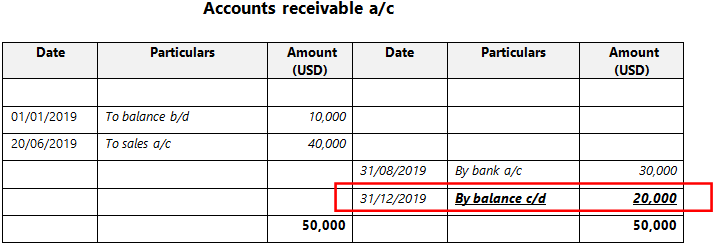Book keeping and accounting is the foundation of an entity’s financial statements. Accounting is done on a continuous basis year on year to be able to generate annual financial statements. Financial statements are prepared from the trial balance, which is a summary of all ledger accounts posted to, after recording accounting entries. Posting to and balancing of ledger accounts is an essential step of accounting.
This article looks at meaning of and differences between two key terms that are relevant in ledger account balancing – balance brought down and balance carried down.
Definitions and meanings
Balance brought down
Balance brought down represents the monetary balance of a real or personal ledger account that is brought in to the books from a previous accounting period. In other words, this is the opening balance of the ledger account.
Balances of nominal ledger accounts are transferred to the income statement each year and are thus not continued into subsequent accounting periods. Balance brought down is thus present only in real and personal accounts that are continued in consecutive accounting periods. Balance brought down is derived from the ledger accounts/trial balance of the previous accounting period.
A proforma of a ledger account reflecting balance brought down is as follows:

In the above example of a current asset – asset receivable account, the first entry posted to the ledger account on the first day of the accounting period is the balance brought down from the previous accounting period. This represents the amount remaining as due to the business from its debtors from previous accounting period/s.
The balance brought down appears on the left side of the ledger account if the total of debits to an account exceeds total of credits to the account, in the previous accounting period. It would appear on the right side of the ledger account if total credits exceed total debits.
Balance carried down
Balance carried down represents the monetary balance of a real or personal ledger account that carried forward to the subsequent accounting period. In other words, this is the closing balance of the ledger account.
Once balance brought down and all debit and credit entries for the accounting period are posted to the ledger account, it is balanced. This is done at the end of the accounting period. In case of nominal ledger accounts, the balancing figure is transferred to the income statement. In case of real and personal accounts, the balancing figure is carried on to the subsequent accounting period as balance carried down.
Modifying the above example, the balance carried down reflected in a proforma of a ledger account is as follows:

In the above example, instead of receiving the entire payment from the debtor, partial payment is received. The balance to be received which is carried forward as a receivable is reflected as balance carried down.
The balance carried down appears on the right side of the ledger account if the total of debits to an account exceeds total of credits to the account, in the current accounting period. It would appear on the left side of the ledger account if total credits exceed total debits.
The balance carried down of one accounting period becomes the balance brought down of the subsequent accounting period.
Difference between balance brought down and balance carried down
The key points of difference between balance brought down and balance carried down have been detailed below:
1. Meaning
- Balance brought down is the opening balance of a ledger account that is brought into the books from a previous accounting period.
- Balance carried down is the closing balance of a ledger account that is carried forward to the next accounting period.
2. Sequence
- Balance brought down is first posting to the ledger account, that is made at the beginning of the accounting period.
- Balance carried down, on the other hand is the last posting (balancing) to the ledger that is done at the the accounting period
3. Derived/calculated from
- Balance brought down is derived from the ledger accounts/trial balance of the previous accounting period. It is the balance carried down of the previous accounting period.
- Balance carried down is calculated after balancing the debits and credits posted to a ledger account. It becomes the balance brought down of the next accounting period.
4. Presentation in ledger account
- Balance brought down is reflected on the left side in case of ledger accounts with debit balance and on the right side in case of ledger accounts with credit balance.
- Balance carried down is reflected on the left side in case of ledger accounts with credit balance and on the right side in case of ledger accounts with debit balance.
5. Transferred to
- Balance brought down is posted to the specific ledger account.
- Balance carried down is transferred to the trial balance of the entity.
Conclusion – balance brought down vs balance carried down
Correct posting of balance brought down and correct calculation of balance carried down is necessary to ensure that the trial balance and financial statements represents the true view of the financial condition of the business. Any error in these postings/balancing will result in an untallied balance sheet. In computerized accounting books today, this process of posting and balancing ledger accounts is done automatically thus greatly minimizing the risk of human totaling errors.

I have liked the explanations